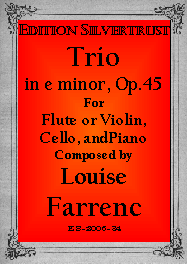Presents
Louise Farrenc
Trio for Flute or Violin, Cello & Piano, Op.45
 Western
societyís general view of women, up until recent times, was in large part
responsible for them not being taken seriously as composers, and for their works
being ignored. Despite this bias, Louise Farrenc (1804-1875) enjoyed a
considerable reputation during her own lifetime as both a performer and a
teacher. Her chamber music is on a par with most of her well-known male
contemporaries, although unfortunately these works never achieved the
renown they deserved and fell into oblivion shortly after her death.
Western
societyís general view of women, up until recent times, was in large part
responsible for them not being taken seriously as composers, and for their works
being ignored. Despite this bias, Louise Farrenc (1804-1875) enjoyed a
considerable reputation during her own lifetime as both a performer and a
teacher. Her chamber music is on a par with most of her well-known male
contemporaries, although unfortunately these works never achieved the
renown they deserved and fell into oblivion shortly after her death.
As a young girl, Farrenc, a piano prodigy, was fortunate in studying with such great masters as Ignaz Moscheles and Johann Nepomuk Hummel. Because she also showed great promise as a composer, her parents enrolled her in the Paris Conservatory when she turned 15. There she studied composition with Anton Reicha. After completing her studies, Farrenc embarked on a concert career and gained considerable fame as a performer. By the early 1840ís, her reputation was such that in 1842 she was appointed to the permanent position of Professor of Piano at the Paris Conservatory, a position she held for thirty years and one which was among the most prestigious in Europe. No woman in the 19th century held a comparable post. At first, during the 1820ís and 1830ís, she composed exclusively for the piano. Several of these pieces drew high praise from critics abroad including Schumann. In the 1840ís, she finally tried her hand at larger compositions for both chamber ensemble and orchestra. It was during this decade that much of her chamber music was written.
Trio in e minor, Op. 45 for Flute, Cello and Piano, composed during 1861-2, is her last chamber work. It was a combination for which, at the time, there were few precedents. A short fanfare, Allegro deciso, leads to the attractive and dramatic main movement, Piu moderato ed espressivo. The main subject of the second movement, Andante, is a sweet vocal melody entrusted to the flute. Farrenc includes a dramatic and turbulent middle section (where our sound-bite begins), a storm interlude. A brilliantly conceived, restless Scherzo vivace comes next. The flute and piano are given running passages, while the cello plays long, sustained notes that create an important atmospheric function. In the trio section, the cello introduces a fine melody high in its tenor register. The superb finale, Presto, begins with a lively theme which picks up speed as it goes along. Later, Farrenc introduces a wonderful second theme which is full of pathos. Discussing Op.45, the editor of The Chamber Music Journal wrote:
" I would say that this trio, if not a masterwork, is at the very least absolutely first rate all the way through. It surely belongs in the concert hall and will also be enjoyed by amateurs. As an aside, satisfying as the version with flute is, I think the substitution of the violin makes the work even more effective."
Alphonse Leduc, who originally published the trio in 1862, successfully encouraged Farrenc to include an alternate violin part. Unfortunately, the Leduc edition, which has long been out of print, is replete with serious errors and lacked rehearsal letters. These were subsequently reproduced by another publisher who, at the end of the last (i.e. the 20th) century, brought out an expensive edition, which was merely a photocopy of the original. While our edition is based on the Leduc version, we have corrected all of the errors of which we are aware and added rehearsal letters.